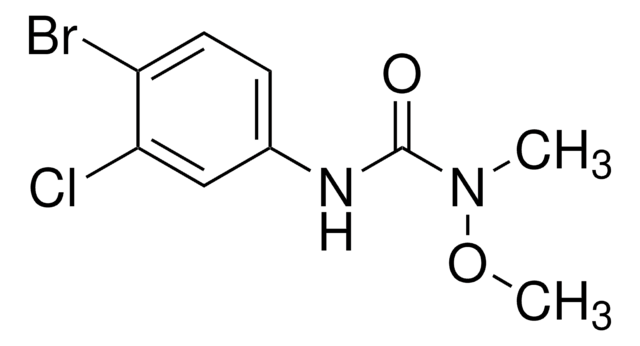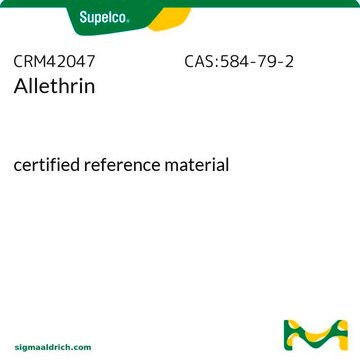93744
Bromopropylate
certified reference material, TraceCERT®, Manufactured by: Sigma-Aldrich Production GmbH, Switzerland
Synonyme(s) :
Isopropyl 4,4′-dibromobenzilate, Phenisobromolate
About This Item
Produits recommandés
Qualité
certified reference material
TraceCERT®
Niveau de qualité
Gamme de produits
TraceCERT®
Durée de conservation
limited shelf life, expiry date on the label
Fabricant/nom de marque
Manufactured by: Sigma-Aldrich Production GmbH, Switzerland
Chaîne SMILES
CC(C)OC(=O)C(O)(c1ccc(Br)cc1)c2ccc(Br)cc2
InChI
1S/C17H16Br2O3/c1-11(2)22-16(20)17(21,12-3-7-14(18)8-4-12)13-5-9-15(19)10-6-13/h3-11,21H,1-2H3
Clé InChI
FOANIXZHAMJWOI-UHFFFAOYSA-N
Vous recherchez des produits similaires ? Visite Guide de comparaison des produits
Catégories apparentées
Description générale
Certified content by quantitative NMR incl. uncertainty and expiry date are given on the certificate.
Download your certificate at: http://www.sigma-aldrich.com
Bromopropylate is a nonsystemic and nonpenetrating acaricide that remains on the peel of fruits and does not migrate into the pulp. It belongs to the family of organophosphate pesticides and is used in the cultivation of lemon trees and other crops. Bromopropylate primarily acts by interfering with the respiratory system. It affects the mitochondria by inhibiting key enzymatic activities and ATP generation, which leads to the formation of reactive oxygen species, and destroys proteins, membranes, unsaturated fatty acids, DNA, etc.
Bromopropylate has to be monitored in the Multiannual Control Programme for Pesticides Residues (MACP), run within the EU and EFTA in/on products of plant origin.
The use of bromopropylate has been banned across the European Union. Maximum residue levels (MRLs) have been set according to Reg. (EU) No 310/2011 for bromopropylate for various products of plant and animal origin from 0.01 to 0.05 mg/kg.
Application
- To elucidate the inhibition of plasma and brain acetylcholinesterase activity in Wistar rats with a mixture of 5 pesticides: chlorpyrifos, alphacypermetrin, bromopropylate, carbendazim, and mancozeb
- Study the degradation processes of bromopropylate, coumaphos, chlordimeform, cymiazole, flumethrin, and fluvalinate in aqueous media by HPLC
- To develop a liquid-phase microextraction method using deep eutectic solvent for extraction and preconcentration of diazinon, metalaxyl, bromopropylate, oxadiazon, and fenazaquin pesticides from samples such as grape and sour cherry juices, fresh beet, cucumber, potato, and tomato followed by gas chromatography-flame ionization detection
- To develop a multi-residue method for the determination of azinphos methyl, bromopropylate, chlorpyrifos, dimethoate, parathion methyl, and phosalone in apricots and peaches using negative chemical ionization ion trap technology
- Simultaneous determination of amitraz, bromopropylate, coumaphos, cymiazole, and fluvalinate residues in honey by solid-phase extraction and GC-MS
Produits recommandés
Informations légales
Mention d'avertissement
Warning
Mentions de danger
Conseils de prudence
Classification des risques
Aquatic Acute 1 - Aquatic Chronic 1
Code de la classe de stockage
11 - Combustible Solids
Classe de danger pour l'eau (WGK)
WGK 3
Point d'éclair (°F)
Not applicable
Point d'éclair (°C)
Not applicable
Faites votre choix parmi les versions les plus récentes :
Certificats d'analyse (COA)
Vous ne trouvez pas la bonne version ?
Si vous avez besoin d'une version particulière, vous pouvez rechercher un certificat spécifique par le numéro de lot.
Déjà en possession de ce produit ?
Retrouvez la documentation relative aux produits que vous avez récemment achetés dans la Bibliothèque de documents.
Notre équipe de scientifiques dispose d'une expérience dans tous les secteurs de la recherche, notamment en sciences de la vie, science des matériaux, synthèse chimique, chromatographie, analyse et dans de nombreux autres domaines..
Contacter notre Service technique








